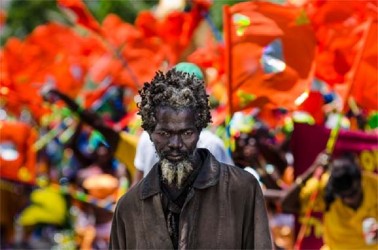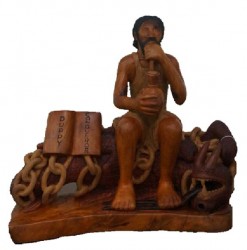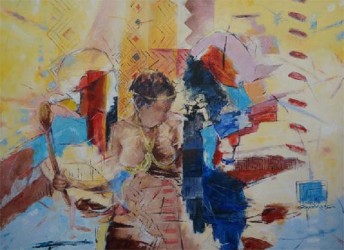By Alim Hosein
Alim A. Hosein is Dean of Education and Humanities at the University of Guyana; a linguist, literary and art critic, artist, member of the Management Committee of the Guyana Prize for Literature and Coordinator of the Guyana Visual Arts Competition and Exhibition (GVACE)
The Awards ceremony held on December 17 at the National Cultural Centre brought an end to the public events in the 2014 Guyana Visual Arts Competition and Exhibition. This ceremony was followed on the same evening by the opening of the exhibition of entries, which will continue until January 31, 2015 at Castellani House.
While the GVACE sees itself as part of the long history of national art competitions and exhibitions in Guyana dating back to the start of the 1930s, it is also a very new competition in the sense that it is taking place in a new era and so faces new challenges. For one thing, the national climate for art is much different today. The social conditions are also different, and artists have different expectations. There is a wider range of artists: professionals, pot-boilers, students, teachers, art lovers, persons creating art at home, artistically-inclined people, among others. There is a very different economic environment and different players in this environment. Value is also measured differently today. Persons also have different expectations of an art competition, and art itself has also changed internationally, and continues to change. Art-making now involves a variety of materials, methods and techniques, and conceptual categories have shifted and changed. While these may not be noticeable at first glance, closer looking shows that Guyanese artists are responding to such innovations.

The GVACE has also taken upon itself work that has not been a feature of previous competitions. This includes public events such as lectures and private meetings, workshops, master-classes and interactions among artists.
A special feature of the Awards Ceremony was the conferring of a Lifetime Achievement Award for service of the highest standard to Guyana in the field of Art to the great Guyanese artist Stanley Greaves. This is the second time that the award has been conferred, the first being bestowed posthumously in 2012 on another great artist, Philip Moore.
The GVACE has also widened the arena from which it recruits judges, as much as it has increased the categories of entries to the competition. Apart from the traditional categories of Painting, Drawing and Sculpture, it includes Photography and Ceramics, and this year it had a new category, Fine Craft.
The competition was launched in July of 2012 and a scarce five months later it mounted a very successful competition which attracted 204 entries from over 90 artists. In 2012, being the first year of the competition after almost twenty years without such an event, artists could have submitted work done up to five years ago. In this year’s competition, they were limited to work done since the last competition, as they will be in future competitions. Yet, this year’s competition garnered 235 entries from a wide cross-section of Guyanese including a housewife, taxi driver, scientist, electrical engineer, IT technician and high-school students, among others, apart from professional and student artists and others who are experienced artists. A total of 99 artists entered the competition, with their ages ranging from 17 to 77. Entries came from afar as the Corentyne, Essequibo, and Soesdyke. There was a noticeable absence of artists living and working in Linden.

A number of young persons entered the competition, with work that showed the influence of anime and cartoon art. The interest showed by these young people is very pleasing, and fulfils one of the aims of the competition, which is to discover and encourage young artists. The works submitted by these young people display undoubted talent which could be developed both in terms of technique and in terms of responding to the life around them.
The overall quality of the exhibition was very good, with more compete, finished, and fully-realised concepts being entered. Photography was, as in 2012, the largest category in terms of entries with 84 entries.

Painting was the next-largest category with 68 entries, followed by Sculpture (31 entries), Drawing (27), Fine Craft (18 entries) and Ceramics (7 entries).
Fine Craft was a new category introduced this year in order to capture the varied work done by many persons in Guyana. In one sense, it is an open category which could include works which do not fall within the traditional categories of painting, drawing and sculpture, and which are done in a single medium or in a combination of media. In another sense, this category sought to encourage an elevation of such work to the level of fine art.
The entries in Photography showed a noticeable movement to larger sizes, which presented challenges to composition, sharpness, and quality which the photographers, by and large, met successfully. On the other hand, there were themes and images such as birds and boats which are becoming familiar.
As expected, Painting produced a much more varied field, ranging from innovative painting on leather to cartoon-like work. In between there was a wide array of themes, approaches and styles, as is always characteristic of Guyanese painting.
In the Sculpture category, artists from the Main Street grouping made up many of the entries, which ensured that the tradition of Guyanese wood carving with its figurative, semi-figurative and abstract forms was well represented.
The low entries in Ceramics is disappointing, given the fact that clay is an easily available material in Guyana, and also that the Burrowes School of Art turns out many students who major in, or have worked in, Ceramics.
In Drawing, there were many interesting entries done in the usual media. However, the nature of this category is such that technical perfection is an absolute, demanding criterion, and this is an area to which our artists need to pay more attention.
Overall, many of the works submitted were on the conservative side, following the styles and lines of development that are well known in Guyanese art. On the other hand, one could see glimpses of diversion from the traditional, well-beaten pathways. Tamayo’s constructed figure in Sculpture, Dominique Hunter’s painting on shaped leather, and Akima McPherson’s installation, are three clear examples of this. Perhaps the competition will stimulate innovation.
The winners in this year’s competition showed the value of training, as most of them came from the established Art training institutions in Guyana. Philbert Gajadhar and Dominique Hunter who won the first and second prizes respectively in Painting; Akima McPherson who, for the second time, was awarded a special prize by the judges; Winslow Craig who took the first prize in Sculpture; Carol Fraser and Trevor Alfred who won the first prize and third prizes respectively in the Fine Craft category and Paloma Bristol who took the second prize in Ceramics all emerged from the Burrowes School of Art. Shimuel Jones (winner of the Promise Award) is a product of the University of Guyana Art programme, while Michael Griffith, who won the first prize in Drawing (for the second time) is a current student. McPherson and Gajadhar were also students in this programme.
But apart from these, the veteran artists came through with Josefa Tamayo winning the second prize in Sculpture and Oswald Hussein the third prize; Walter Gobin won the second prize in Drawing; Merlene Ellis won the third prize in Painting and Irene Bacchus-Holder took the second prize in Fine Craft, while Nicholas Young won the first prize in Ceramics. In Photography, while there is no training school, established photographer Fidal Bassier won the first prize while newcomers Roshinee Latchana and Karran Sahadeo won the second and third prizes.
The judges for this year’s competition were Guyanese artist resident in New York, Carl Hazlewood; Surinamese artist George Struikelblok; Trinidadian academic and artist Kenwyn Crichlow; Guyanese artist Ivor Thom and Arts designer and administrator Daphne Rogers.
The 2014 GVACE showed that there is a great interest among Guyanese in art creation. The work on show at Castellani House is a stunning display of creativity that will please many different tastes and all who love art (the pieces are also on sale should anyone wish to keep an example of Guyanese creativity in their home or office). One suspects that for the next competition, artists will be thinking harder about their submissions. A competition of this nature attracts a wide range of work, so there may be a big gap between the pieces that win and those that do not. It is hoped that with successive competitions, this gap will be narrowed.
With this in mind, we look forward to the next competition in 2016.




